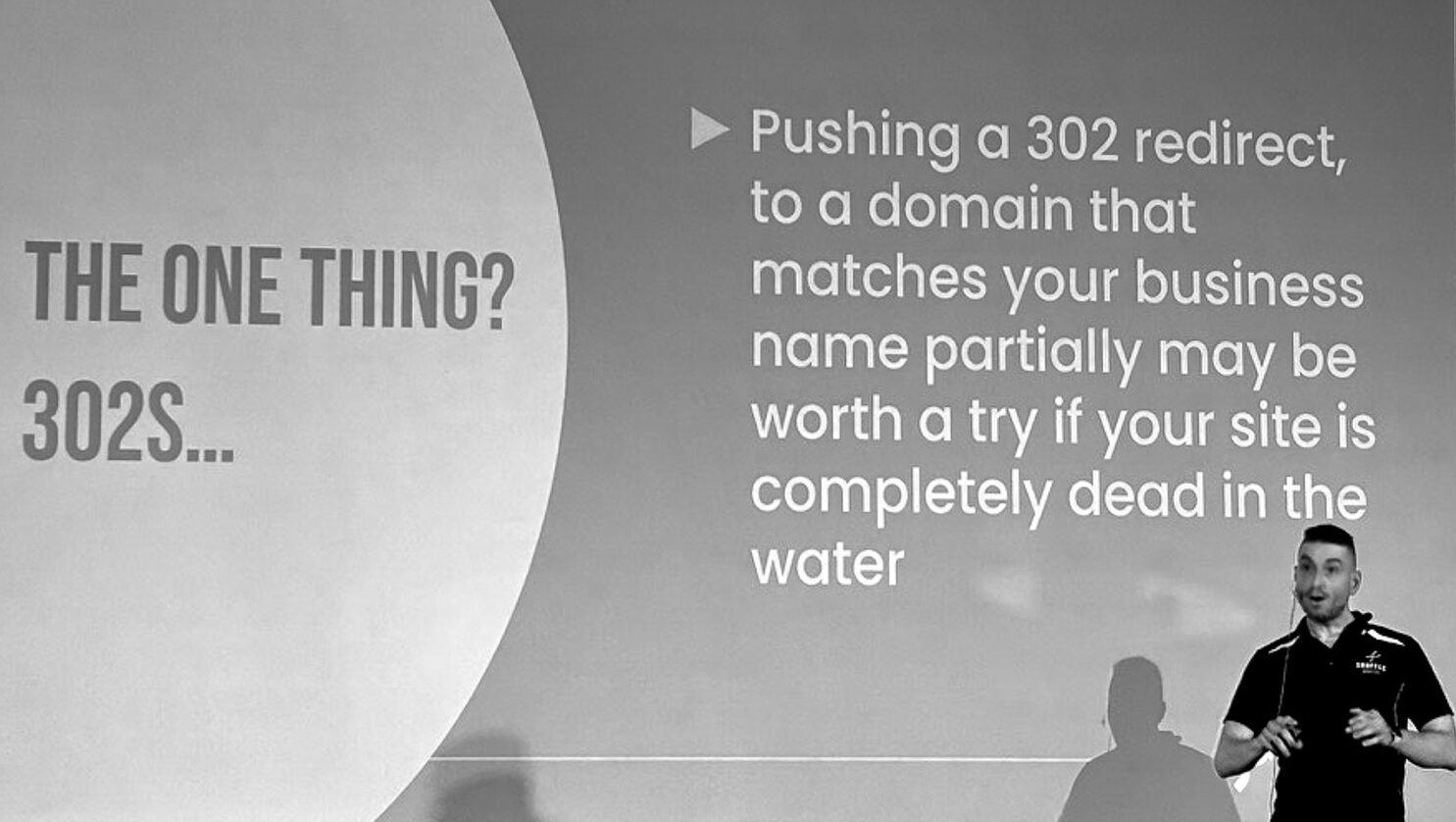In a presentation at a recent SEO conference, Dejan Mladenovski shared his experience recovering a site severely impacted by Google’s Helpful Content Update (HCU). The site, which lost approximately 95% of its traffic post-HCU, achieved full traffic recovery through an unconventional technical SEO approach using 302 redirects – a method that contradicts standard SEO practices. This recovery occurred three days before Google’s official HCU reversal update, making it particularly noteworthy for sites still struggling with HCU impacts.
Background and Initial Impact
The Site Profile
- Lead generation site with moderate traffic (25,000-30,000 visitors/month)
- Content primarily generated using GPT-3
- Minimal expertise signals and author documentation
- Revenue primarily dependent on SEO traffic
- Approximately 500 pages of content
HCU Impact Timeline
- September 2023: Initial HCU hit with 80-85% traffic drop
- March 2024: Further decline to 95% traffic loss
- August 4, 2024: Recovery to pre-HCU traffic levels
- August 7, 2024: Google’s official HCU reversal update
Technical Recovery Strategy
Core Technical Approach
- Domain Migration using 302 Redirects
- Unconventional use of 302 (temporary redirect) instead of standard 301 redirects (permanent redirect)
- One-to-one page mapping for all content
- No new backlink building during migration
- Domain Selection Criteria
- Expired domain containing relevant industry keywords
- Similar geographic top-level domain
- Existing authority and clean link profile
- Previous traffic history in same country
Content Management
- Content Removal
- Eliminated 300 GPT-4 generated pages
- Removed affiliate content pages
- Maintained original GPT-3 content without updates
- Technical Implementation Details
- Maintained same Google Analytics Measurement ID
- Kept identical design and logo
- Retained same email address structure
- No Google Search Console setup on new domain
Analysis of Success Factors
Key Technical Insights
- 302 Redirect Theory
- Temporary redirect status may prevent HCU penalty transfer
- Based on agency migration experience patterns
- Allows for testing without permanent commitment
- Domain Authority Transfer
- Two-hop redirects resulted in 10-20% authority loss
- Maintained partial keyword relevance through domain selection
- Preserved existing backlink profile without new building
Risk Factors and Considerations
- Implementation Risks
- Potential for complete traffic loss
- Resource investment in migration
- Uncertainty of long-term stability
- Technical Debt
- Multiple redirect hops affecting site speed
- Maintenance complexity
- Future migration challenges
Current Testing and Future Implications
Ongoing Experiments
- Redirect Removal Testing
- Systematic removal of redirects every two weeks
- Three-month evaluation period
- Testing authority retention without redirects
- Domain Migration Testing
- Planned migration to third domain
- Testing repeatability of recovery method
- Evaluating long-term viability
Strategic Considerations
- Technical SEO Impact
- Challenges traditional redirect best practices
- Questions permanence of HCU penalties
- Suggests technical workarounds for content penalties
- Long-term Viability
- Uncertainty about future Google updates
- Resource requirements for implementation
- Scalability across different site types
Action Items for SEO Practitioners
- Assessment Phase
- Evaluate traffic patterns matching HCU impact timeline
- Audit content quality against Google’s helpful content guidelines
- Analyze current redirect and domain structure
- Technical Preparation
- Identify suitable expired domains meeting selection criteria
- Map out complete redirect structure
- Prepare monitoring and measurement framework
- Implementation Considerations
- Document all current site metrics and baselines
- Create rollback plan for potential issues
- Set up comprehensive tracking across both domains
- Risk Mitigation
- Maintain original domain and structure
- Phase implementation if possible
- Monitor key performance indicators daily
- Long-term Strategy
- Plan for potential future migrations
- Develop content quality improvement roadmap
- Build authority signals on new domain
Critical Limitations and Caveats
- Case Study Specifics
- Single site example
- Specific niche and content type
- Unique timing relative to Google updates
- Implementation Risks
- No guarantee of similar results
- Resource-intensive process
- Potential for complete traffic loss
- Long-term Uncertainties
- Future Google algorithm updates
- Scalability across different sites
- Maintenance requirements
Conclusion
This case study presents a novel technical SEO approach to recovering from the HCU update through strategic use of 302 redirects and domain migration. While the method shows promise, it requires careful consideration of implementation risks and resource requirements. The ongoing testing and future implications suggest this could be a valuable addition to the technical SEO recovery toolkit, particularly for sites severely impacted by content-based penalties.
This approach challenges traditional SEO best practices regarding redirect usage and raises important questions about the nature of Google’s helpful content system. As with any technical SEO strategy, practitioners should carefully evaluate their specific situation and resources before implementing similar measures.
The success of this case study suggests that technical SEO solutions may still be viable for content-based penalties, though long-term sustainability remains to be proven. Continued monitoring of the test cases and future Google updates will be crucial for understanding the broader applicability of this approach.
